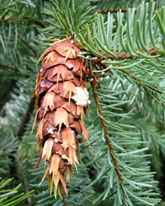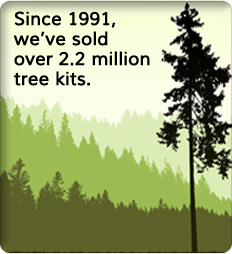 Loading... Please wait...
Loading... Please wait...- 1-800-343-2313
- Home
- My Account
- Gift Certificates
- View Cart
- Home
- Info/Blog
- Tree Types
- Douglas Fir
Douglas Fir
Pseudotsuga taxifolia glauca
 Growing to 330' tall, the Douglas Fir is one of the largest trees. The Fir was the first Christmas tree because its great height was thought to bring clear vision in the face of the New Year. With dark blue-green needles and a broad, full shape, this tree will grow in all the U.S. except the Deep South coasts.
Growing to 330' tall, the Douglas Fir is one of the largest trees. The Fir was the first Christmas tree because its great height was thought to bring clear vision in the face of the New Year. With dark blue-green needles and a broad, full shape, this tree will grow in all the U.S. except the Deep South coasts.
By its others names of Douglas Spruce, Douglas Yew and Oregon Pine, one begins to realize what a botanical puzzle this tree has been. The Douglas Fir is actually neither Spruce, Yew nor Pine and was given the Greek name Pseudo-tsuga describing it as a "false hemlock with a yew-like leaf". It was first "discovered" on Vancouver Island By Dr. Archibald Menzies in 1791, and rediscovered in 1827 by the Scottish botanist, David Douglas. Douglas sent seeds back to the British Isles where they were widely planted and given his name.
 Part of the Pine Family, (which includes Pines, Firs, Spruce, Cedars, and other conifers), the Douglas Fir is second only to the Giant Sequoia as the largest tree, growing 80-325' tall, with trunk diameters of 2-17'. It is a very straight evergreen with upward growing branches that can become slightly droopy with age. It has a dense crown with a conical shape & short blue-green needles (3/4 - 1 1/4"). Its cones are narrow and egg-shaped with scaly seed leaves.
Part of the Pine Family, (which includes Pines, Firs, Spruce, Cedars, and other conifers), the Douglas Fir is second only to the Giant Sequoia as the largest tree, growing 80-325' tall, with trunk diameters of 2-17'. It is a very straight evergreen with upward growing branches that can become slightly droopy with age. It has a dense crown with a conical shape & short blue-green needles (3/4 - 1 1/4"). Its cones are narrow and egg-shaped with scaly seed leaves.
The Douglas Fir is one of the most important timber species in the world, being a very strong wood, and it is the biggest timber producer in the United States. It is a popular Christmas Tree and ornamental and is widely used in reforestation and windbreak plantings. Wildlife feed off its foliage and seeds.
Natural Habitat of the Douglas Fir: There are two main varieties of this tree. The coastal variety forms vast forests in the moist well-drained soils from British Columbia to Central California. The Rocky Mountain variety is a hardier tree growing in drier, rockier soils ranging from Canada to Mexico. Elevation: 0' to 11,000'. As little as 15" of rain per year to 100" of rain. Adaptable to all but the most swampy soils. High resistance to cold. Moderate resistance to drought.






